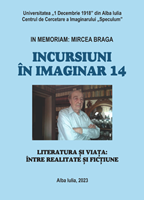DETERMINĂRILE EXTERIOARE ȘI INFLUENȚELE MODURILOR PSIHOGENE ÎN LITERATURA TRAUMATICĂ (KENZABURŌ ŌE, IOANA NICOLAIE)
EXTERNAL DETERMINATIONS AND INFLUENCES OF PSYCHOGENIC MODES IN THE TRAUMA LITERATURE (KENZABURŌ ŌE, IOANA NICOLAIE)
Author(s): Rebeca-Rahela MarchedonSubject(s): Romanian Literature, Sociology of Culture, Theory of Literature, Sociology of Literature
Published by: Editura Aeternitas
Keywords: Traumatic imaginary; psychogenic influences; disastrous events; intergenerational transmission; alternative world; person vs. character; copied truths; temporal and spatial determinations;
Summary/Abstract: The ideational framework underlying the proposed study is based on the influences that migrate from the fact to the fiction. In the light of this decryption, reality is rebuilt inside literature, and the character becomes a prototype of the person, of the real being. Therefore, the phenomenon is explained by referring the author to the cultural (spatial) and temporal (historical) determinations. The re-discussion of representative prose for distinct continental topos (Kenzaburō Ōe, Stârpiți răul de la rădăcină, împușcați copiii – Japan/Asia; Ioana Nicolaie, Pelinul negru – Romania/Europe), through the lens of psychogenic constructs, on the one hand, and of external conditions, on the other, demonstrates to what extent the traumas of a society, more precisely, individual mutilations, are reflected in artistic creation. The copied truths take the form of alternative worlds in which the wars, the topos of the authors' childhood, the violent marginal of society, the dysfunctional relations between parent and child become deconstructed and reassembled reminiscences, which reproduce the architectural model of the prefigured primary reality. We observe how Pelinul negru, or "black grass", as the author herself calls it, embodies the drama of the nuclear explosion at Chernobyl, felt on all levels by the child character. In the selected prose, Kenzaburō Ōe also tells us about infantile characters, as embodiments of his own childhood. In Stârpiți răul de la rădăcină, împușcați copiii childhood is transfigured through the grotesque lens of the Second World War - from the perspective of the plagues characteristic for the conflagration times and the hostile relations between the individual and otherness.
Journal: Incursiuni în imaginar
- Issue Year: 1/2023
- Issue No: 14
- Page Range: 177-193
- Page Count: 17
- Language: Romanian

